Make money online,
Online marketing
How to Convert More Visitors By Improving Your Internal Site Search
01:50
According to eConsultancy, up to 30% of eCommerce visitors will use internal site search. Typically speaking, due to the increased level of purchase intent, are also known to convert sometimes up to 5-6X higher than the average non-site search visitor.
Natural language processing software Inbenta mentions in this article a client who noticed their site search customers converted 43% higher, and eConsultancy talks about cases where site search visitors are making up as much as 13.8% of the overall revenue.
And yet, I can almost guarantee that more than half of ConversionXL readers aren’t paying attention to site search.

It’s too bad then that in another study by eConsultancy, it was discovered that only 15% of companies have dedicated resources to optimizing the site search experience, with 42% including it into a wider range of responsibilities (which less face it, internal search probably isn’t at the top of the priority list) and another 42% neglecting it all together.

What’s even worse though is that only 7% of companies report they’re efficiently learning from internal site search data & using that in other areas of their business.

In another study by SLI Systems surveying 160 eCommerce professionals, it was found that nearly 6 out of 10 people don’t use site search data for any of their marketing programs.

Now, if you fall into this category, I need to ask you a very serious question… Where else are visitors telling you exactly the thing they’re looking for & the words they use to describe it, when they’re on your site?
Don’t worry, I can wait while you come up with an answer.
Now let me ask you this, why in the world would you neglect this data?

I mean, assuming you have site search set up properly in Google Analytics, if you knew that the majority of people are searching for “Coffee Tables” don’t you think you could do something with that data?

Or what if you knew a search for ABC product – the second most searched product on your site – had an average order value of $111.89, but had 1,619 fewer searches than XYZ product at $99.94… Don’t you think you could do something with that information?

Well, according to SLI, the biggest challenges are:

The thing is, what 86.7% of those surveyed might not realize, is that setting up internal site search is free and relatively easy with Google Analytics, so let’s get rid of those top 3 excuses, shall we?
 Then click on “view settings” under the view column on the far right side of the page.
Then click on “view settings” under the view column on the far right side of the page.
 From here, scroll down the page to where it says “Site Search Settings” then switch the toggle from Off to On:
From here, scroll down the page to where it says “Site Search Settings” then switch the toggle from Off to On:
 To find the Query parameter, go to your site and perform a search in the search bar, then check the url to see what shows up before the search term.
To find the Query parameter, go to your site and perform a search in the search bar, then check the url to see what shows up before the search term.


In this case, the query parameter would be “s”, but depending on how your site is set up, it may also be “q”,”search”,”query”, or “term”.
If your eCommerce set up also has the ability to search within categories (via a dropdown for example) than you can also track the individual categories by adding them to the “site search categories option, right below the site search tracking.

Having this information will allow you to see the most commonly searched phrases within each category, helping you to uncover your most profitable (internal) keywords.
This insight can inform everything from future Adwords campaigns to what products to feature within specific categories & search results (a.k.a Searchendising).
Graham Charlton of eConsultancy has written an excellent piece on how to make the most out of your site search data, I highly recommend you check it out.
This what Jason Dupus of Black Forest Décor did with their company site back in 2008, which resulted in a 20% jump in conversions and an 84% jump in revenue for customers using search.
Before:

After:

There are 4 major things they did to the search field to make it more noticeable:
Other things worth testing might also be microcopy in the search field – such as the top searched terms, and a stronger visual cue on the search button

In some cases, this might be because the product is discontinued, out of stock, or something you don’t carry. In this case, instead of showing a “no results found” page, try Matt Cutt’s recommendation of showing a “related products” page (at least for smaller retailers) or a “temporarily out of stock” option, if you plan on carrying the item again.
 For the keywords that are getting refined often though, this is going to be a matter of delivering better search results for they keywords getting search. To find what these refined terms are, click on the keyword, then “refined keyword ” in the primary dimension area, you can see the most common refinements of the search query.
For the keywords that are getting refined often though, this is going to be a matter of delivering better search results for they keywords getting search. To find what these refined terms are, click on the keyword, then “refined keyword ” in the primary dimension area, you can see the most common refinements of the search query.
 In some cases, this may be as simple as improving how you’ve tagged the content on your site, and removing products that you have no intention of ever re-stocking.
In some cases, this may be as simple as improving how you’ve tagged the content on your site, and removing products that you have no intention of ever re-stocking.
In other cases though, depending on the volume of your store, timeliness of your products, selection, etc – you may want to invest in a more robust search solution that will help you to provide even more relevant results.
Our two favorite platforms for this are SearchSpring:

And SearchNode:

If you’re in the major leagues for eCommerce though, I’d highly recommend you check out Adobe’s marketing cloud, as the site search data can be tied to customer profiles & personalized based on customer segments.

In this case study by IBM, client Footsmart.com was able to improve their conversion rate for site searchers by 82%, by enacting a weekly monitoring campaign of underperforming search terms, and adjusting the results accordingly.

Basically, Searchandizing is take advantage of the keyword being searched to feature more profitable products in the search results.
Here’s a couple of examples of search merchandizing in action:

Here we see Sports Unlimited clearly featuring North Face winter jackets & free shipping on North Face products. While this is being shown in The North Face category here, this banner & featured sellers could also be translated to generic keyword phrases such as “winter jackets”, “hoodies” “fleeces” etc.
In this next example by Target, (by way of PracticaleCommerce) you can very easily see the attempt to Merchandize a Dslr camera among other point & shoot cameras within a similar price range.

For visitors who might not have been considering a DSLR camera, simply seeing it being weighed against the other results which they were more accustomed to expect, could help the budding photographer get into a “next step up” camera.
The same goes for them also clearly marking “Clearance” items in the search results to simultaneously push older inventory, while making newer inventory look more appealing.

Even without manipulating the results to make certain products more appealing, searchandizing can also include giving multiple presentation options & filters for the user to find the products that are right for them.

While faceted navigation & the ability to personalize search is certainly nothing new, this is something that, according to a usability report by 37Signals., 68% of the top 25 leading retailers offered minimal to no sorting/filtering for search results.

This is surprising, especially when small sites like BuyAKilt.com in this now classic case study, are able to increase their revenues by 76% just by adding product filters to their site search results.

Overall, just by giving searchers the ability to better sort their options, BuyaKilt was able to increase conversions by 26% & shopping cart visits by 19.76%.
Who knows how much more revenue could be gained if they started optimizing thecheckout flow after?
Natural language processing software Inbenta mentions in this article a client who noticed their site search customers converted 43% higher, and eConsultancy talks about cases where site search visitors are making up as much as 13.8% of the overall revenue.
And yet, I can almost guarantee that more than half of ConversionXL readers aren’t paying attention to site search.
The Massive Growth Opportunity & Competitive Advantage For Focusing On Site Search
When Screen Pages shared the results of 21 of it’s clients, they found that in all but one case, that the average revenue that was generated from site search was significantly higher from the of people performing searches on the site – with the most notable example showing that even though less than 10% of people were performing searches, close to 40% of the site’s revenue came from those searchers.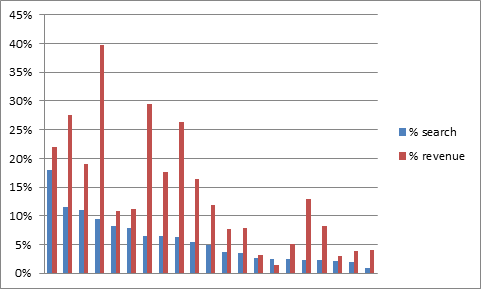
It’s too bad then that in another study by eConsultancy, it was discovered that only 15% of companies have dedicated resources to optimizing the site search experience, with 42% including it into a wider range of responsibilities (which less face it, internal search probably isn’t at the top of the priority list) and another 42% neglecting it all together.
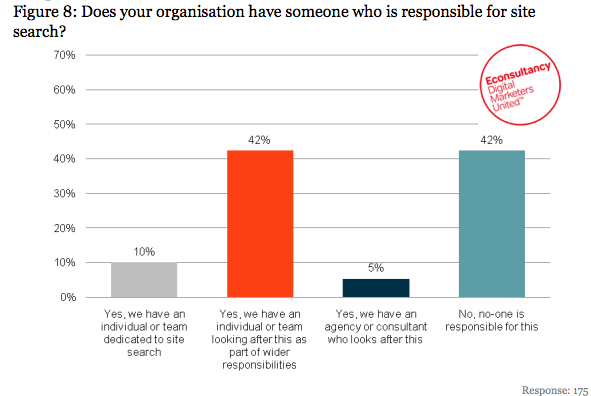
What’s even worse though is that only 7% of companies report they’re efficiently learning from internal site search data & using that in other areas of their business.
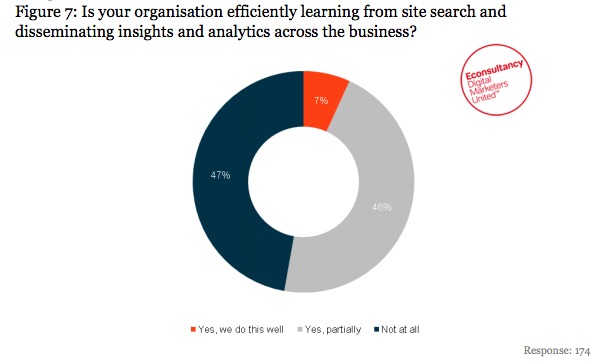
In another study by SLI Systems surveying 160 eCommerce professionals, it was found that nearly 6 out of 10 people don’t use site search data for any of their marketing programs.
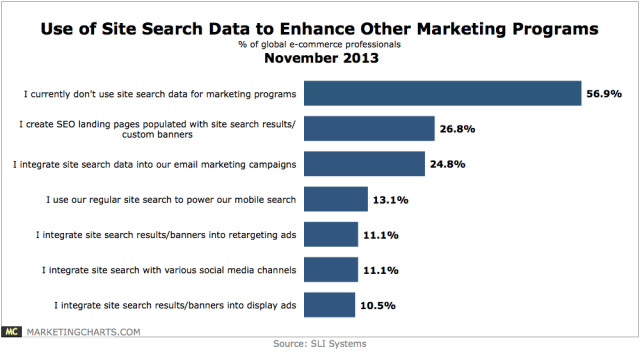
Now, if you fall into this category, I need to ask you a very serious question… Where else are visitors telling you exactly the thing they’re looking for & the words they use to describe it, when they’re on your site?
Don’t worry, I can wait while you come up with an answer.
Now let me ask you this, why in the world would you neglect this data?

I mean, assuming you have site search set up properly in Google Analytics, if you knew that the majority of people are searching for “Coffee Tables” don’t you think you could do something with that data?

Or what if you knew a search for ABC product – the second most searched product on your site – had an average order value of $111.89, but had 1,619 fewer searches than XYZ product at $99.94… Don’t you think you could do something with that information?
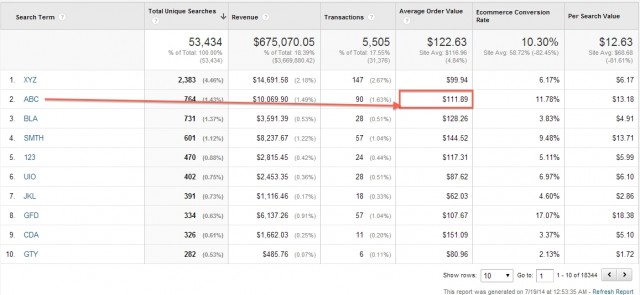
Well, according to SLI, the biggest challenges are:
- My site search doesn’t allow this
- I’m not sure how to do it
- Limited resources
- Not a priority

The thing is, what 86.7% of those surveyed might not realize, is that setting up internal site search is free and relatively easy with Google Analytics, so let’s get rid of those top 3 excuses, shall we?
Setting Up Internal Site Search With Google Analytics
Assuming you already have Google Analytics for eCommerce set up, in Google Analytics, click on “Admin” in the top navigation. Then click on “view settings” under the view column on the far right side of the page.
Then click on “view settings” under the view column on the far right side of the page.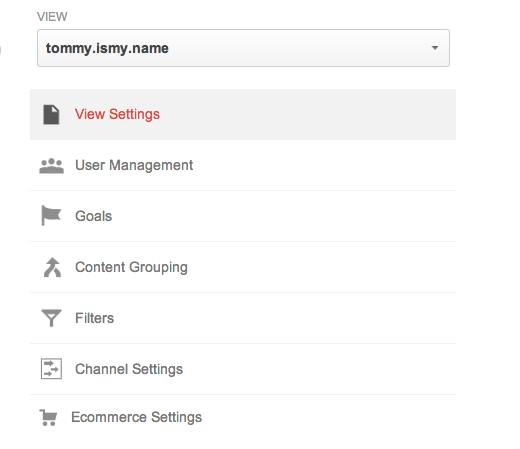 From here, scroll down the page to where it says “Site Search Settings” then switch the toggle from Off to On:
From here, scroll down the page to where it says “Site Search Settings” then switch the toggle from Off to On: To find the Query parameter, go to your site and perform a search in the search bar, then check the url to see what shows up before the search term.
To find the Query parameter, go to your site and perform a search in the search bar, then check the url to see what shows up before the search term.
In this case, the query parameter would be “s”, but depending on how your site is set up, it may also be “q”,”search”,”query”, or “term”.
If your eCommerce set up also has the ability to search within categories (via a dropdown for example) than you can also track the individual categories by adding them to the “site search categories option, right below the site search tracking.
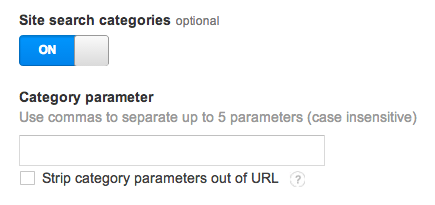
This insight can inform everything from future Adwords campaigns to what products to feature within specific categories & search results (a.k.a Searchendising).
Graham Charlton of eConsultancy has written an excellent piece on how to make the most out of your site search data, I highly recommend you check it out.
Increasing Conversions By Improving The Search Experience
The question is, how can we use this data to increase the revenue from our internal site searchers even more? While there are many best practice tips & effective design patterns for site search and results pages, for the sake of brevity, I’m going to share with you my top three favorite methods.Method 1 – More Emphasis on The Search Bar
It would stand to reason that if a majority of the money comes from search, then you should make it easier for visitors to find the search bar.This what Jason Dupus of Black Forest Décor did with their company site back in 2008, which resulted in a 20% jump in conversions and an 84% jump in revenue for customers using search.
Before:
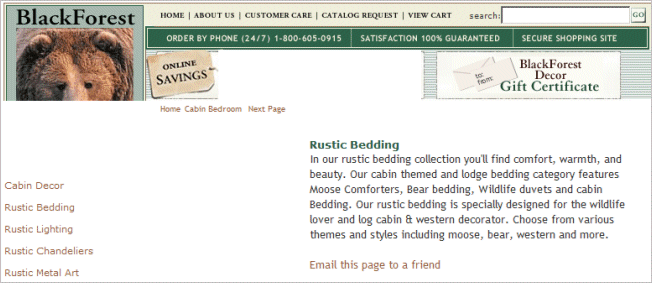
After:

There are 4 major things they did to the search field to make it more noticeable:
- Increased the overall pixel size by 72%
- Moved it to the center of the page
- Improved the CTA from “Go” to “Find”
- Added color to the search box
Other things worth testing might also be microcopy in the search field – such as the top searched terms, and a stronger visual cue on the search button
Method 2 – Removing & Improving Search Results
So, let’s say we pulled the search report for last quarter, and noticed that our top search “Coffee Tables” had a 34.62% exit rate after the search was performed, and a 12.86% search refinement – this means that over a third of the people who searched this keyword didn’t find what they were looking for, and left the site all-together.
In some cases, this might be because the product is discontinued, out of stock, or something you don’t carry. In this case, instead of showing a “no results found” page, try Matt Cutt’s recommendation of showing a “related products” page (at least for smaller retailers) or a “temporarily out of stock” option, if you plan on carrying the item again.
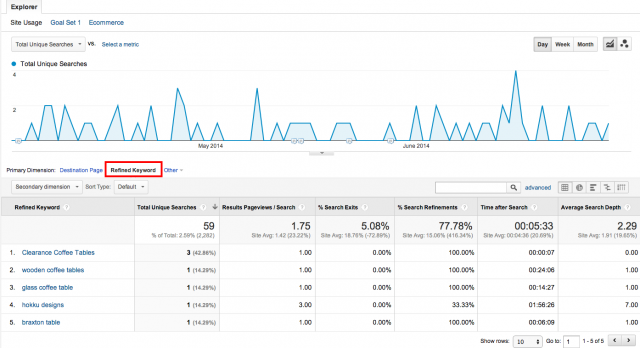 In some cases, this may be as simple as improving how you’ve tagged the content on your site, and removing products that you have no intention of ever re-stocking.
In some cases, this may be as simple as improving how you’ve tagged the content on your site, and removing products that you have no intention of ever re-stocking.In other cases though, depending on the volume of your store, timeliness of your products, selection, etc – you may want to invest in a more robust search solution that will help you to provide even more relevant results.
Our two favorite platforms for this are SearchSpring:
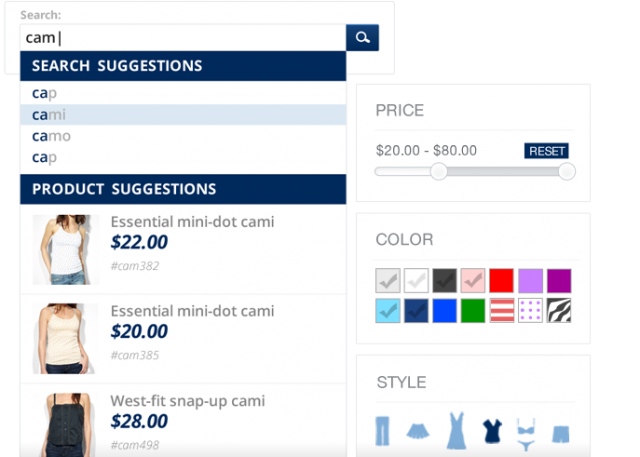
And SearchNode:
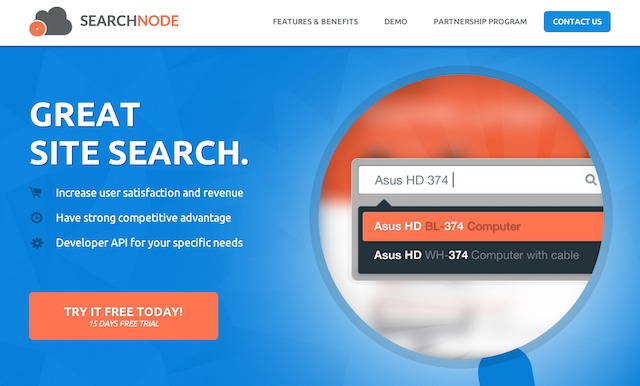
If you’re in the major leagues for eCommerce though, I’d highly recommend you check out Adobe’s marketing cloud, as the site search data can be tied to customer profiles & personalized based on customer segments.
In this case study by IBM, client Footsmart.com was able to improve their conversion rate for site searchers by 82%, by enacting a weekly monitoring campaign of underperforming search terms, and adjusting the results accordingly.
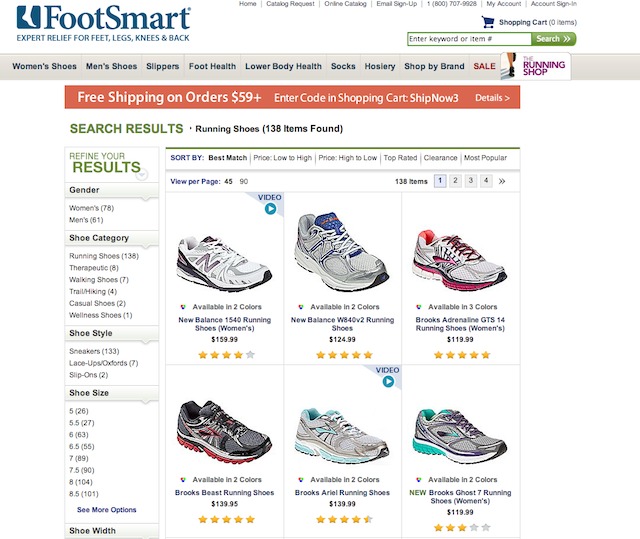
“With over 50,000 unique searches each month, FootSmart.com’s improved search conversion rate will drive multi-million dollar revenue gains this year as well as additional learning and insight into effective merchandising strategies via on-site search”
Method 3 – Searchandizing
This is perhaps my favorite, because this is a term I had never heard before.Basically, Searchandizing is take advantage of the keyword being searched to feature more profitable products in the search results.
Here’s a couple of examples of search merchandizing in action:
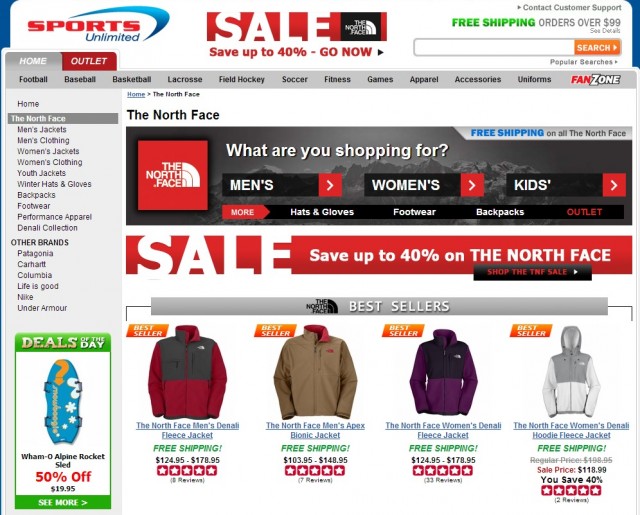
Here we see Sports Unlimited clearly featuring North Face winter jackets & free shipping on North Face products. While this is being shown in The North Face category here, this banner & featured sellers could also be translated to generic keyword phrases such as “winter jackets”, “hoodies” “fleeces” etc.
In this next example by Target, (by way of PracticaleCommerce) you can very easily see the attempt to Merchandize a Dslr camera among other point & shoot cameras within a similar price range.
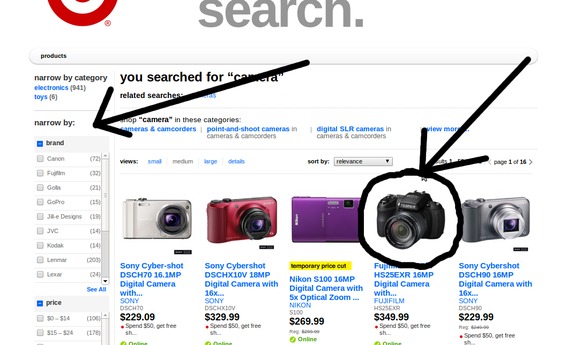
For visitors who might not have been considering a DSLR camera, simply seeing it being weighed against the other results which they were more accustomed to expect, could help the budding photographer get into a “next step up” camera.
The same goes for them also clearly marking “Clearance” items in the search results to simultaneously push older inventory, while making newer inventory look more appealing.
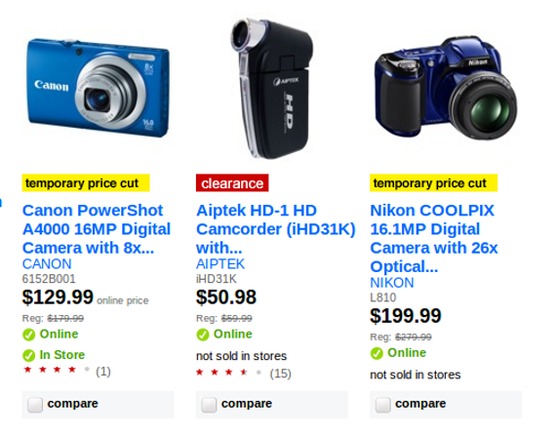
Even without manipulating the results to make certain products more appealing, searchandizing can also include giving multiple presentation options & filters for the user to find the products that are right for them.

While faceted navigation & the ability to personalize search is certainly nothing new, this is something that, according to a usability report by 37Signals., 68% of the top 25 leading retailers offered minimal to no sorting/filtering for search results.

This is surprising, especially when small sites like BuyAKilt.com in this now classic case study, are able to increase their revenues by 76% just by adding product filters to their site search results.
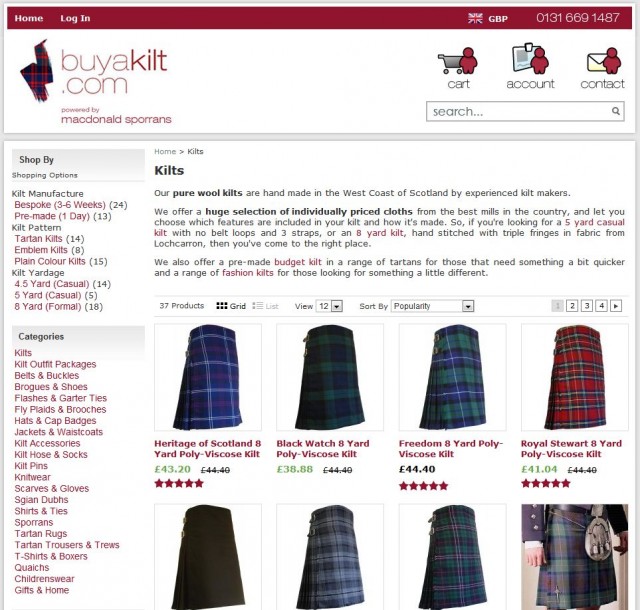
Overall, just by giving searchers the ability to better sort their options, BuyaKilt was able to increase conversions by 26% & shopping cart visits by 19.76%.
Who knows how much more revenue could be gained if they started optimizing thecheckout flow after?
Conclusion
There is still plenty more to talk about as it relates to optimizing your visitor’s site search experience, but for now, I’d like you to answer two questions:- What method here stood out the most?
- What methods have you been using that you’ve found to be the most effective?






0 comments